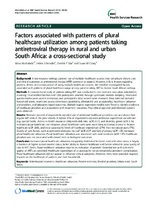| dc.contributor.author | Moshabela, Mosa | |
| dc.contributor.author | Schneider, Helen | |
| dc.contributor.author | Silal, Sheetal | |
| dc.contributor.author | Cleary, Susan | |
| dc.date.accessioned | 2013-02-22T14:14:09Z | |
| dc.date.available | 2013-02-22T14:14:09Z | |
| dc.date.issued | 2012 | |
| dc.identifier.citation | Moshabela, M. (2012). Factors associated with patterns of plural healthcare utilization among patients taking antiretroviral therapy in rural and urban South Africa: a cross sectional study. BMC Health Research Services, 12:182 | en_US |
| dc.identifier.issn | 1472-6963 | |
| dc.identifier.uri | http://hdl.handle.net/10566/547 | |
| dc.description.abstract | Background: In low-resource settings, patients’ use of multiple healthcare sources may complicate chronic care
and clinical outcomes as antiretroviral therapy (ART) continues to expand. However, little is known regarding
patterns, drivers and consequences of using multiple healthcare sources. We therefore investigated factors
associated with patterns of plural healthcare usage among patients taking ART in diverse South African settings.
Methods: A cross-sectional study of patients taking ART was conducted in two rural and two urban sub-districts,
involving 13 accredited facilities and 1266 participants selected through systematic random sampling. Structured
questionnaires were used in interviews, and participant’s clinic records were reviewed. Data collected included
household assets, healthcare access dimensions (availability, affordability and acceptability), healthcare utilization
and pluralism, and laboratory-based outcomes. Multiple logistic regression models were fitted to identify predictors
of healthcare pluralism and associations with treatment outcomes. Prior ethical approval and informed consent
were obtained.
Results: Nineteen percent of respondents reported use of additional healthcare providers over and above their
regular ART visits in the prior month. A further 15% of respondents reported additional expenditure on self-care
(e.g. special foods). Access to health insurance (Adjusted odds ratio [aOR] 6.15) and disability grants (aOR 1.35)
increased plural healthcare use. However, plural healthcare users were more likely to borrow money to finance
healthcare (aOR 2.68), and incur catastrophic levels of healthcare expenditure (27%) than non-plural users (7%).
Quality of care factors, such as perceived disrespect by staff (aOR 2.07) and lack of privacy (aOR 1.50) increased
plural healthcare utilization. Plural healthcare utilization was associated with rural residence (aOR 1.97). Healthcare
pluralism was not associated with missed visits or biological outcomes.
Conclusion: Increased plural healthcare utilization, inequitably distributed between rural and urban areas, is largely
a function of higher socioeconomic status, better ability to finance healthcare and factors related to poor quality of
care in ART clinics. Plural healthcare utilization may be an indication of patients’ dissatisfaction with perceived
quality of ART care provided. Healthcare expenditure of a catastrophic nature remained a persistent complication.
Plural healthcare utilization did not appear to influence clinical outcomes. However, there were potential negative
impacts on the livelihoods of patients and their households. | en_US |
| dc.language.iso | en | en_US |
| dc.publisher | BioMed Central | en_US |
| dc.rights | © 2012 Moshabela, et al; licensee BioMed Central Ltd.This is an Open Access article distributed under the terms of the Creative Commons Attribution License, which permits unrestricted use, distribution, and reproduction in any medium, provided the original work is properly cited. | |
| dc.source.uri | http://dx.doi.org/10.1186/1472-6963-12-182 | |
| dc.subject | Antiretroviral treatment | en_US |
| dc.subject | Healthcare utilisation | en_US |
| dc.subject | Patient retention | en_US |
| dc.subject | Medical pluralism | en_US |
| dc.subject | Urban-rural | en_US |
| dc.subject | South Africa | en_US |
| dc.title | Factors associated with patterns of plural healthcare utilization among patients taking antiretroviral therapy in rural and urban South Africa: a cross sectional study | en_US |
| dc.type | Article | en_US |
| dc.privacy.showsubmitter | false | |
| dc.status.ispeerreviewed | true | |
| dc.description.accreditation | Web of Science | en_US |

